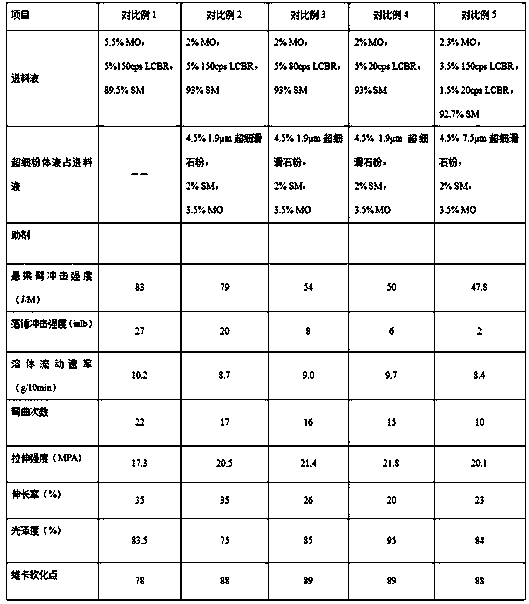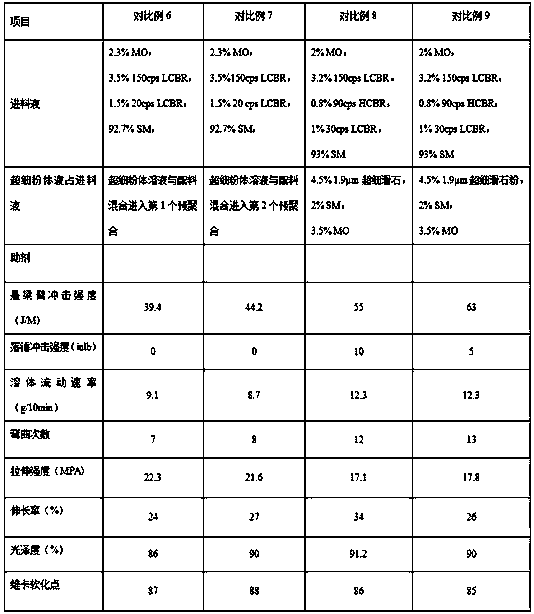A kind of medium impact polystyrene resin and preparation method thereof
A technology of impact polystyrene and styrene series, which is applied in the field of medium impact polystyrene resin and its preparation, and can solve problems such as increased labor, poor secondary blending effect, and reduced product fluidity
- Summary
- Abstract
- Description
- Claims
- Application Information
AI Technical Summary
Problems solved by technology
Method used
Image
Examples
Embodiment 1
[0080] 1. Preparation method
[0081] A preparation method of medium-impact polystyrene resin, comprising the following steps:
[0082] (1) Preparation of feed liquid: by weight percentage of feed liquid, 2% mineral oil, 3.2% low-cis polybutadiene rubber with solution viscosity of 150 cps, 0.8% solution viscosity of 90 cps high cis polybutadiene rubber, 1% solution viscosity of 30 cps low cis polybutadiene rubber, dissolved in 93% styrene monomer, prepared as a rubber solution and fed as feed liquid In the first-stage continuous stirred tank reactor (using the continuous stirred tank reactor as the pre-polymerization reactor);
[0083] (2) Continuous polymerization: Add 50 ppm of initiator (dibenzoyl peroxide) to carry out polymerization at 95°C to reach a conversion rate of 8%, and then send it to the second-stage continuous stirred tank reactor (second-stage pre-polymerization reaction device);
[0084] (3) Polymerize at a reaction temperature of 128°C to achieve a conver...
Embodiment 2
[0088] 1, other conditions are identical with embodiment 1, difference is:
[0089] (1) Add 0.05% n-octadecyl 3-(3,5-di-tert-butyl-4-hydroxyphenyl) propionate (antioxidant agent), while adding 1200 ppm of zinc stearate (internal lubricant) and 200 ppm of ethylene bisstearamide (external lubricant) to the final granule product in the first-stage plug flow reactor;
[0090] (2) Add 4% of superfine talc powder with an average particle size of 1 µm, 2% of styrene monomer and 3.5% of mineral oil to the first-stage plug flow reactor after mixing and dissolving in the powder treatment tank;
[0091] (3) Three-stage plug flow reactors are set up. The temperatures controlled by the plug flow reactors at each stage are 138°C, 165°C, and 180°C; the conversion rates are 43%, 63%, and 76%.
[0092] 2. Please refer to Table 1-3 for specific product characteristics and physical and chemical properties.
Embodiment 3
[0094] 1, other conditions are identical with embodiment 1, difference is:
[0095] (1) Mineral oil accounting for 2% by weight of the feed liquid, low-cis polybutadiene rubber (solution viscosity of 150 cps) accounting for 2.5% by weight of the feed liquid, and 0.7% by weight of the feed liquid High cis polybutadiene rubber (solution viscosity is 30 cps) and low cis polybutadiene rubber (solution viscosity is 30 cps) accounting for 1.8% by weight of the feed liquid are dissolved in 93% by weight of the feed liquid In the styrene monomer, the rubber solution is prepared as the feed liquid and sent to the first-stage continuous stirred tank reactor;
[0096] (2) Set up 4-stage plug flow reactors. The temperatures controlled by each stage of plug flow reactors are 139°C, 158°C, 167°C, and 180°C; the conversion rates are 41%, 53%, 62%, and 78%.
[0097] 2. Please refer to Table 1-3 for specific product characteristics and physical and chemical properties.
PUM
| Property | Measurement | Unit |
|---|---|---|
| particle size | aaaaa | aaaaa |
| particle size | aaaaa | aaaaa |
| particle diameter | aaaaa | aaaaa |
Abstract
Description
Claims
Application Information
 Login to View More
Login to View More - R&D
- Intellectual Property
- Life Sciences
- Materials
- Tech Scout
- Unparalleled Data Quality
- Higher Quality Content
- 60% Fewer Hallucinations
Browse by: Latest US Patents, China's latest patents, Technical Efficacy Thesaurus, Application Domain, Technology Topic, Popular Technical Reports.
© 2025 PatSnap. All rights reserved.Legal|Privacy policy|Modern Slavery Act Transparency Statement|Sitemap|About US| Contact US: help@patsnap.com



